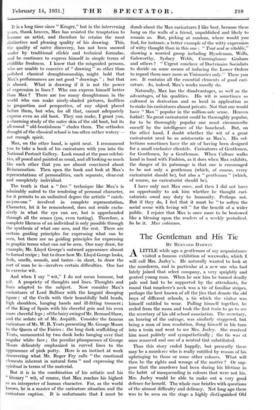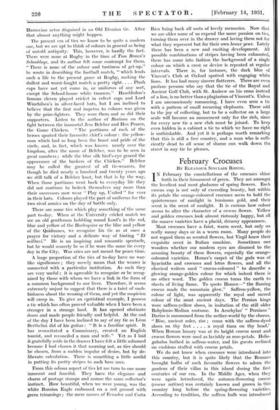The Gentleman and His Tie By BERNARD DARWIN A LITTLE while
ago a gentleman of my acquaintance visited a famous exhibition of waxworks, which I will call Mrs. Jarley's. He naturally wanted to look at the murderers, and in particular at a new one who had lately joined that select company, a very sprightly and genteel young man. When he saw him he turned deadly pale and had to be supported by the attendants, for round that murderer's neck was a tie of familiar stripes, perhaps the best known of all the ties that denote the old boys of different schools, a tie which the visitor was himself entitled to wear. Pulling himself together, he reeled from the room and took the first train to go to see the secretary of his old school association. The secretary, on hearing of the outrage, was similarly staggered, but being a man of iron resolution, flung himself in his turn into a train and went to see Mrs. Jarley. She received him most politely and sympathetically ; the tie was at Once removed and one of a neutral tint substituted.
Thus this story ended happily; but presently there may be a murderer who is really entitled by reason of his upbringing to those or some other colours. What will then be the rights and wrongs of the matter ? Or sup- pose that the murderer had been during his lifetime in the habit of masquerading in colours that were not his. Mrs. Jarley would be able to make out a very good defence for herself. The whole case bristles with questions of the utmost difficulty and delicacy. Not long ago there was to be seen on the stage a highly distinguished Old Harrovian actor disguised in an Old Etonian tie. After that almost anything might happen.
The present era of ties we know to be quite a modern one, but we are apt to think of colours in general as being of untold antiquity. This, however, is hardly the fact. There were none at Rugby in the time of Tom Brown's Schooldays, and its author felt some contempt for them. " There is none of the colour and tastiness of get-up," he wrote in describing the football match, " which lends such a life to the present game at Rugby, making the dullest and worst-fought match a pretty sight. . . . Plush caps have not yet come in, or uniforms of any sort; except the School-house white trousers." Hambledon's famous eleven played cricket in velvet caps and Lord Winchilsea's in silver-laced hats, but I am inclined to believe that the first real impetus to colours was given by the prize-fighters. They wore them and so did their supporters. Listen to the author of Boxiana on the fight between the immortal Jem Belcher and Hen Pearce, the Game Chicken. " The partizans of each of the heroes sported their favourite chief's colour : the yellow- man which had so long been the boast and pride of the circle, and, in fact, which was known nearly over the kingdom, after the name of Belcher, was to be seen in great numbers ; while the blue silk bird's-eye graced the appearance of the backers of the Chicken." Belcher may be called the greatest of all tie-wearers, for though he died nearly a hundred and twenty years ago we still talk of a Belcher knot, but that is by the way. When those partizans went back to everyday life they did not continue to bedeck themselves any more than their successors now wear " Play up, United " for ever in their hats. Colours played the part of uniforms for the two rival armies on the day of battle only.
There are some tics which play something of the same part to-day. When at the University cricket match we see an old gentleman hobbling round Lord's in the red, blue and yellow of the Harlequins or the blue and yellow of the Quidnunes, we recognize his tie as at once a prayer for victory and a delicate way of hinting " Et militavi." He is an inspiring and romantic spectacle, but he would scarcely be so if he wore the same tie every day in the City. War cries are not meant for peace time.
A large proportion of the ties of to-day have no war- like significance ; they merely mean that the wearer is connected with a particular institution. As such they are very useful ; it is agreeable to recognize or be recog- nized by those with whom we have a link in the form of a common background to our lives. Therefore, it seems extremely unjust to suggest that there is a taint of snob- bishness about the weaning of them, and yet the suspicion will creep in. To give an egotistical example, I possess a tie which has often proved valuable when I have been a stranger in a strange land. It has opened obstinate doors and made people friendly and helpful. At the end of the day I have been inclined to say of my tie as Leon Berthclini did of his guitar : " It is a familiar spirit. It. has resuscitated a Commissary, created an English tourist, and reconciled a man and wife." Yet as I laid it gratefully aside in the drawer I have felt a little ashamed because I had chosen it that morning not, as ties should be chosen, from a sudden impulse of desire, but by de- liberate calculation. There is something a little sordid in putting its pretty stripes to such base uses.
From this odious aspect of ties let me turn to one more innocent and fanciful. They have the elegance and charm of postage stamps and arouse the same collector's - instinct. • How beautiful, when we were young, was the white Russian Eagle embossed on a red ground with- green trimmings ; the mere names of Ecuador and Costa Rica bring back all sorts of lovely memories. Now that we are older some of us expend the same passion on ties, turning them over in the drawer and loving them not for what they represent but for their own beaux yeux. Lately there has been a new and exciting development. All possible combinations of stripes having been exhausted, there has come into fashion the background of a single colour on which a crest or device is repeated at regular intervals. There is, for instance, the dark blue of Vincent's Club at Oxford spotted with engaging white lions. It has had many sincere flatterers. There are even profane persons who say that the tie of the Royal and Ancient Golf Club, with St. Andrew on his cross instead of a lion, is no better than a plagiarism of Vincent's. Unless I am unconsciously romancing, I have even seen a tie with a pattern of small recurring elephants. These add to the joy of collecting, but to be a collector on a large scale will become an amusement only for the rich, since for every new tie a new club must be joined. To keep even hidden in a cabinet a tie to which we have no right is unthinkable. And yet it is perhaps worth remarking that this is still a free country, and a man who is suffi- ciently dead to all sense of shame can walk down the street in any tie he pleases,
















































 Previous page
Previous page